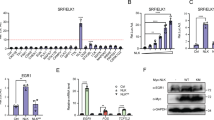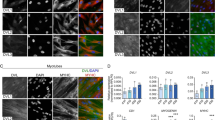Abstract
Chronic overexpression of the oncogenic form of Ras is a potent inhibitor of skeletal myogenesis. However, the intracellular signaling pathways that mediate the repressive actions of Ras on myogenic differentiation have yet to be identified. We examined the role of Raf-mediated signaling as a modulator of avian myogenesis. Raf overexpression elicited pronounced effects on both myoblasts and mature myocytes. Most notably, the embryonic chick myoblasts overexpressing a constitutively active form of Raf (RCAS-Raf CAAX or RCAS-Raf BXB) fail to form the large multinucleated myofibers characteristic of myogenic cultures. While residual myofibers were apparent in the RCAS-Raf BXB and RCAS-Raf CAAX infected cultures, these fibers had an atrophic phenotype. The altered morphology is not a result of reinitiation of the myonuclei cell cycle nor is it due to apoptosis. Furthermore, the mononucleated myoblasts misexpressing Raf BXB are differentiation-defective due to overt MAPK activity. Supplementation of the culture media with the MAPK kinase (MEK) inhibitor, PD98059, caused a reversal of the phenotype and allowed the formation of multinucleated myofibers at levels comparable to controls. Our results indicate that the Raf/MEK/MAPK axis is intact in chick myoblasts and that persistent activation of this signaling cascade is inhibitory to myogenesis.
This is a preview of subscription content, access via your institution
Access options
Subscribe to this journal
Receive 50 print issues and online access
$259.00 per year
only $5.18 per issue
Buy this article
- Purchase on Springer Link
- Instant access to full article PDF
Prices may be subject to local taxes which are calculated during checkout






Similar content being viewed by others
References
Alema S and Tato F. . 1994 Semin. Cancer Biol. 5: 147–156.
Avruch J, Zhang X and Kyriakis JM. . 1994 Trends Biochem. Sci. 19: 279–283.
Bennett AM and Tonks N. . 1997 Science 278: 1288–1291.
Bruder JT, Heidecker G and Rapp UR. . 1992 Genes Dev. 6: 545–556.
Coolican SA, Samuel DS, Ewton DZ, McWade FJ and Florini JR. . 1997 J. Biol. Chem. 272: 6653–6662.
DeAngelis L, Borghi S, Melchionna R, Berghella L, Baccarani-Contri M, Parisse F, Ferrari S and Cossu G. . 1998 Proc. Natl. Acad. Sci. USA 95: 12358–12363.
Denhardt DT. . 1996 Biochem. J. 318: 729–747.
Downward J. . 1998 Curr. Opin. Gen. Dev. 8: 49–54.
Duckworth BC and Cantley LC. . 1997 J. Biol. Chem. 272: 27665–27670.
Florini JR, Ewton DZ and Magri KA. . 1991 Annu. Rev. Physiol. 53: 201–216.
Fukuda M, Gotoh Y, Tachibana T, Dell K, Hattori S, Yoneda Y and Nishida E. . 1995 Oncogene 11: 239–244.
Gredinger E, Gerber AN, Tamir Y, Tapscott SJ and Bengal E. . 1998 J. Biol. Chem. 273: 10436–10444.
Hardy S, Kong Y and Konieczny SF. . 1993 Mol. Cell Biol. 10: 5943–5956.
Hermann M, Lorenz H-M, Voll R, Grunke M, Woith W and Kalden JR. . 1994 Nucl. Acid. Res. 22: 5506–5507.
Joneson T and Bar-Sagi D. . 1997 J. Mol. Med. 75: 587–595.
Kauffman-Zeh A, Rodriguez-Viciana P, Ulrich E, Gilbert C, Coffer P, Downward J and Evan G. . 1997 Nature 385: 544–548.
Kaliman P, Canicio J, Shepherd PR, Beeton CA, Testar X, Palacin M and Zorzano A. . 1998 Mol. Endocrinol. 12: 66–77.
Kong YF, Johnson SE, Taparowsky EJ and Konieczny SF. . 1995 Mol. Cell. Biol. 15: 5202–5213.
Konieczny SF, Drobes BL, Menke SL and Taparowsky EJ. . 1989 Oncogene 4: 473–481.
Lassar AB, Thayer MJ, Overell RW and Weintraub H. . 1989 Cell 58: 659–667.
Lassar AB and Munsterberg A. . 1996 Curr. Op. Neurobiol. 6: 57–63.
Li L, Zhou J, James G, Heller-Harrison R, Czech MP and Olson EN. . 1992 Cell 71: 1181–1194.
Ludolph DC and Koniecnzy SF. . 1995 FASEB J. 9: 1595–1604.
Marshall CJ. . 1995 Cell 80: 179–185.
Molkentin JD and Olson EN. . 1996 Curr. Opin. Gen. Dev. 6: 445–453.
Olson EN, Spizz G and Tainsky MA. . 1987 Mol. Cell. Biol. 7: 2104–2111.
Olson EN. . 1992 Dev. Biol. 154: 261–272.
Petropoulos SJ and Hughes SH. . 1991 J. Virol. 65: 3728–3737.
Ramocki MB, Johnson SE, White MA, Ashendel CL, Konieczny SF and Taparowsky EJ. . 1997 Mol. Cell. Biol. 17: 3547–3555.
Takano H, Momuro I, Oka T, Shiojima I, Hiroi Y, Mizuno T and Yazaki Y. . 1998 Mol. Cell. Biol. 18: 1580–1589.
Turner DL and Weintraub H. . 1994 Genes Dev. 8: 1434–1447.
Ueda Y, Hirai S, Osada S, Suzuki A, Mizuno K and Ohno S. . 1996 J. Biol. Chem. 271: 23512–23519.
Vaidya TB, Weyman CM, Teegarden D, Ashendel CL and Taparowsky EJ. . 1991 J. Cell Biol. 114: 809–820.
White MA, Nicolette C, Minden M, Polverino A, VanAelst L, Karin M and Wigler MJ. . 1995 Cell 80: 533–541.
Xu R-H, Dong Z, Maeno M, Kim J, Suzuki A, Ueno N, Sredi D, Colburn NH and Kung HF. . 1996 Proc. Natl. Acad. Sci. USA 93: 834–838.
Acknowledgements
This work was supported by grants to SE Johnson from the United States Department of Agriculture (NRICGP 9803668) and the American Heart Association-Pennsylvania Affiliate (BP8419P).
Author information
Authors and Affiliations
Rights and permissions
About this article
Cite this article
Dorman, C., Johnson, S. Activated Raf inhibits avian myogenesis through a MAPK-dependent mechanism. Oncogene 18, 5167–5176 (1999). https://doi.org/10.1038/sj.onc.1202907
Received:
Revised:
Accepted:
Published:
Issue Date:
DOI: https://doi.org/10.1038/sj.onc.1202907
Keywords
This article is cited by
-
Delineating v-Src downstream effector pathways in transformed myoblasts
Oncogene (2008)
-
Raf-induced effects on the differentiation and apoptosis of skeletal myoblasts are determined by the level of Raf signaling: abrogation of apoptosis by Raf is downstream of caspase 3 activation
Oncogene (2002)
-
Insulin restores differentiation of Ras-transformed C2C12 myoblasts by inducing NF-κB through an AKT/P70S6K/p38-MAPK pathway
Oncogene (2002)
-
Differential effects of Ras signaling through NFκB on skeletal myogenesis
Oncogene (2001)
-
Rap1A protein interferes with various MAP kinase activating pathways in skeletal myogenic cells
Oncogene (2000)



